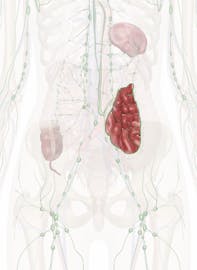The Peyer's Patches
Explore the anatomy and role of the Peyer's patches in the immune system with Innerbody's 3D model.

Peyer's patches are small masses of lymphatic tissue found throughout the ileum region of the small intestine. Also known as aggregated lymphoid nodules, they form an important part of the immune system by monitoring intestinal bacteria populations and preventing the growth of pathogenic bacteria in the intestines.
Peyer's patches are roughly egg-shaped lymphatic tissue nodules that are similar to lymph nodes in structure, except that they are not surrounded by a connective tissue capsule. They belong to a class of non-encapsulated lymphatic tissue known as lymphatic nodules, which include the tonsils and lymphatic tissue of the appendix. Special epithelial cells known as microfold cells line the side of the Peyer's patch facing the intestinal lumen, while the outer side contains many lymphoid cells and lymphatic vessels.
The function of Peyer's patches is to analyze and respond to pathogenic microbes in the ileum. Antigens from microbes in the gut are absorbed via endocytosis by microfold cells lining the surface of each Peyer's patch. These antigens are passed on to the lymphoid tissue, where they are absorbed by macrophages and presented to T lymphocytes and B lymphocytes. When presented with dangerous pathogenic antigens, lymphocytes trigger the immune response by producing pathogen-specific antibodies; turning into pathogen-killing cytotoxic T lymphocytes; and migrating through lymphatic vessels to lymph nodes to alert the other cells of the immune system. The body then prepares a full body-wide immune response to the pathogen before it is able to spread beyond the intestines.



